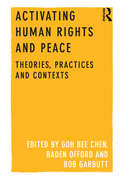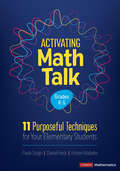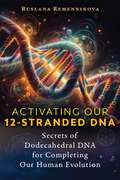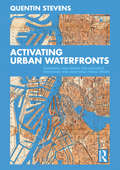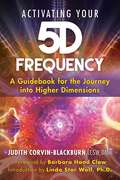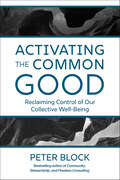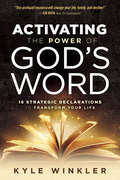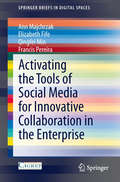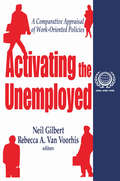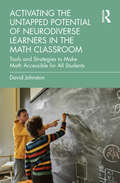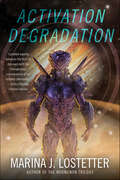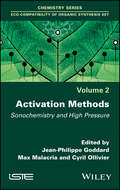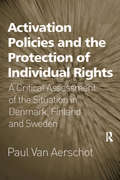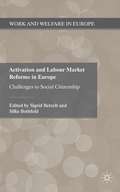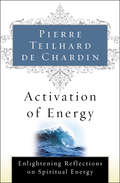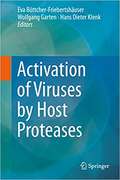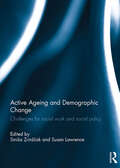- Table View
- List View
Activating Human Rights and Peace: Theories, Practices and Contexts
by GOH Bee Chen Baden OffordHuman rights and peace issues and concerns have come about at a critical time. The world has recently witnessed a plethora of turning points that speak of the hopes and vulnerabilities which are inherent in being human and demonstrate that change in the service of human rights and peace is possible. At the same time, however, other events indicate that wherever there is life, there is vulnerability in a world characterized by instability and endemic human suffering. On top of all this, the collapse of the global financial system and the serious, rapid destruction of the environment have brought the world to a precarious state of vulnerability. Activating human rights and peace is, therefore, a project that is always in progress, and is never finally achieved. This enlightening collection of well thought through cases is aimed at academics and students of human rights, political science, law and justice, peace and conflict studies and sociology.
Activating Linguistic and Cultural Diversity in the Language Classroom (Educational Linguistics #55)
by Enrica Piccardo Aline Germain-Rutherford Geoff Lawrence Angelica GalanteThis book challenges the reader to rethink and reimagine what diversity in language education means in transnational societies. Bringing together researchers and practitioners who contributed to the international LINguistic and Cultural DIversity REinvented (LINCDIRE) project, the book examines four pillars of innovation in language education: the Action-oriented approach, Plurilingualism, Indigenous epistemologies and Technology enhanced learning. The book critically discusses plurilingual pedagogical approaches that draw on learners' linguistic and cultural repertoires to encourage and support the dynamic use of languages in curricular innovation. It is a fundamental resource for language teachers, curriculum designers and educational researchers interested in understanding current thinking on the relevance and benefit of a plurilingual paradigm shift for language education in today's societies. More specifically, this book: Examines the development of plurilingualism and the potential of real-life oriented teaching and learning. Explores the concept of plurilingual and pluricultural competence. Focuses on collaboration and reflection from a humanistic tradition. Explores educational technology and explains the limitations and challenges of adopting ready-made tools. Highlights the iterative, design-based research process that informed the development of LINCDIRE’s pedagogical framework and action-oriented scenarios. Introduces practical examples of action-oriented tasks and scenarios, and illustrates the online tool (LITE) in terms of its current functionalities and design. Describes the implementation challenges and opportunities of plurilingual action-oriented tasks and discusses the results of implementation. Finally, the book examines future pedagogical innovation and research directions in order to help readers reflect on the implications of achieving sustainable change in language education.This exciting collection addresses an important question in language education: How can plurilingualism and cultural diversity be harnessed to promote sustainable innovation in language learning and teaching? Readers will find contributions from the diverse authors timely, compelling, and engaging.— Dr. Bonny Norton, FRSC, University Killam Professor, UBC Dept. of Language & Literacy Education, CanadaEmbracing a design-based research framework, this book offers learners and teachers powerful validation and a rich, relatable and inspiring action-oriented approach to holistic, dynamic, mediated, embodied, true-to-life, plurilingual language teaching and learning.— Dr. Elka Todeva, Professor of Applied Linguistics, MATESOL Program / Advanced Seminar in Plurilingual Pedagogy, SIT Graduate Institute, Washington, D.C.Anyone seeking innovation in Language Education will find in this volume a treasure trove of theoretical, empirical and methodological insights to answer the questions that arose among the 25 co-authors’ discussions to rethink language use, language learning, and language teaching.— Dr. Mercedes Bernaus, Emeritus Professor, Universitat Autònoma de Barcelona, SpainThis thought-provoking and timely book argues convincingly for the need to reconceptualize innovation in language education in an increasingly diverse world. —Dr. Regine Hampel, Associate Dean (Research Excellence), Faculty of Wellbeing, Education and Language Studies, The Open University, UK
Activating Math Talk: 11 Purposeful Techniques for Your Elementary Students (Corwin Mathematics Series)
by Paola Sztajn Daniel Heck Kristen MalzahnAchieve High-Quality Mathematics Discourse With Purposeful Talk Techniques Many mathematics teachers agree that engaging students in high quality discourse is important for their conceptual learning, but successfully promoting such discourse in elementary classrooms—with attention to the needs of every learner—can be a challenge. Activating Math Talk tackles this challenge by bringing practical, math-specific, productive discourse techniques that are applicable to any lesson or curriculum. Framed around 11 student-centered discourse techniques, this research-based book connects purposeful instructional techniques to specific lesson goals and includes a focus on supporting emergent multilingual learners. You will be guided through each technique with Classroom examples of tasks and techniques spanning grades K–5 Reflection moments to help you consider how key ideas relate to your own instruction Classroom vignettes that illustrate the techniques in action and provide opportunities to analyze and prepare for your own implementation Group discussion questions for engaging with colleagues in your professional community Achieving high-quality mathematics discourse is within your reach using the clear-cut techniques that activates your math talk efforts to promote every student’s conceptual learning.
Activating Math Talk: 11 Purposeful Techniques for Your Elementary Students (Corwin Mathematics Series)
by Paola Sztajn Daniel Heck Kristen MalzahnAchieve High-Quality Mathematics Discourse With Purposeful Talk Techniques Many mathematics teachers agree that engaging students in high quality discourse is important for their conceptual learning, but successfully promoting such discourse in elementary classrooms—with attention to the needs of every learner—can be a challenge. Activating Math Talk tackles this challenge by bringing practical, math-specific, productive discourse techniques that are applicable to any lesson or curriculum. Framed around 11 student-centered discourse techniques, this research-based book connects purposeful instructional techniques to specific lesson goals and includes a focus on supporting emergent multilingual learners. You will be guided through each technique with Classroom examples of tasks and techniques spanning grades K–5 Reflection moments to help you consider how key ideas relate to your own instruction Classroom vignettes that illustrate the techniques in action and provide opportunities to analyze and prepare for your own implementation Group discussion questions for engaging with colleagues in your professional community Achieving high-quality mathematics discourse is within your reach using the clear-cut techniques that activates your math talk efforts to promote every student’s conceptual learning.
Activating Our 12-Stranded DNA: Secrets of Dodecahedral DNA for Completing Our Human Evolution
by Ruslana Remennikova• Reveals how vibration and intention can transform DNA from the standard double helix to its 12-stranded form, unlocking your physical and spiritual potential• Explores the intimate relationship of water and DNA and how they both react to sound and consciousness• Shares ten specific frequencies that resonate with DNA as well as techniques and meditations to activate your 12-stranded DNA for emotional and physical healing, resolution of ancestral trauma, and conscious evolutionIn this vibrant guidebook, sound healer and former corporate scientist Ruslana Remennikova reveals how, through vibration and intention, you can shapeshift DNA from the standard double helix to its 12-stranded, dodecahedral form—thereby unlocking your spiritual potential and opening the way for deep healing of the past, the present, and the future of your deeper self.Examining the alchemy behind the 12 strands of our DNA, the author looks at the intimate relationship between water and DNA, showing how both respond to vibrational frequencies as well as to consciousness. She also shows how unresolved grief creates oxidative stress in the body that targets our cellular mitochondrial DNA, leading to psychological and physical illnesses. She explains how sound can transform our DNA into an evolutionary activator and healing mechanism, helping the body to detox, resolve grief and trauma, and address stress-induced imbalances at the cellular level.Sharing techniques and meditations that help you activate all 12 strands of your DNA, the author reveals the revolutionary healing powers inherent in each of us for personal healing, spiritual transformation, and the completion of our human evolution.
Activating Urban Waterfronts: Planning and Design for Inclusive, Engaging and Adaptable Public Spaces
by Quentin StevensActivating Urban Waterfronts shows how urban waterfronts can be designed, managed and used in ways that can make them more inclusive, lively and sustainable. The book draws on detailed examination of a diversity of waterfronts from cities across Europe, Australia and Asia, illustrating the challenges of connecting these waterfront precincts to the surrounding city and examining how well they actually provide connection to water. The book challenges conventional large scale, long-term approaches to waterfront redevelopment, presenting a broad re-thinking of the formats and processes through which urban redevelopment can happen. It examines a range of actions that transform and activate urban spaces, including informal appropriations, temporary interventions, co-design, creative programming of uses, and adaptive redevelopment of waterfronts over time. It will be of interest to anyone involved in the development and management of waterfront precincts, including entrepreneurs, the creative industries, community organizations, and, most importantly, ordinary users.
Activating Voices in Jazz History: Students Broadening the Narrative (CMS Emerging Fields in Music)
by Anthony D.J. BrankerActivating Voices in Jazz History: Students Broadening the Narrative highlights the research of students who have been challenged to assess and interpret evidence found in historical records and engage in field interviews with a diverse representation of jazz artists. This approach serves as a method for co-creating a living history of jazz.Drawing from the author’s experience in teaching jazz historiography and recognizing that Jazz, African American music, and the music of the African diaspora offer unique perspectives rooted in culture and community, the book presents a culturally relevant view of the history of jazz. It also proposes a much-needed alternative methodology for teaching this subject. The author reflects on the issues that shape the framing of jazz history and discusses how using a dialogic approach can enable students to engage in critical conversations. The student-led interviews with artists focus on themes such as diversity and inclusion, gender equity, social justice, cultural identity and identification, what the word “jazz” represents, primitivism, reflections on pedagogy, the current state of jazz education, and the development of artistic voice and creative self-expression.This concise book will be a valuable resource for jazz educators, scholars, students, and enthusiasts alike.
Activating Your 5D Frequency: A Guidebook for the Journey into Higher Dimensions
by Judith Corvin-BlackburnA guide to navigating the transition from 3D to 5D and reclaiming the ancient powers of love, creativity, and unity consciousness lying dormant in our DNA • Details what is happening psychologically, emotionally, and socially with the dimensional shift and provides a vision of life on 5D Earth • Offers transformative activations and tools to meet the psycho-spiritual demands of this transition, including identifying and integrating the shadow self, healing emotional wounds, and discovering higher frequencies • Explains how to navigate the Ascension process, especially in terms of handling emotions, resistances, and fears, and how to welcome these new frequencies We are in a time of great transition. Higher frequency light is flooding our planet, awakening large numbers to reclaim our original nature as fifth-dimensional humans. As 5D humans, we live from our heart&’s wisdom, from Unity Consciousness, unconditional love, and unbridled creativity. 5D humans have highly developed inner senses of empathy, telepathy, clairvoyance, and clairsentience--qualities that are opening for many as we go through this dimensional shift. While this journey is exciting, its demands can be overwhelming. In this hands-on guide to activating the 5D potential lying dormant in our DNA, Judith Corvin-Blackburn shows us how to navigate the Ascension process, including how to handle emotions, resistances, and fears and welcome our 5D frequencies. Using the 9-dimensional-axis theory first explored by Barbara Hand Clow, the author details what is happening psychologically, emotionally, and socially with the dimensional shift, including revealing the denser, pain-inducing frequency of being a 3D human and the challenges of the 4th dimension. She offers transformative activations and tools to explore and master the psycho-spiritual demands of this transition, including identifying and integrating the shadow self, healing emotional wounds that hold us back, and discovering higher frequencies and the cellular vibration of unconditional love and Oneness. Once we reclaim ourselves as loving, conscious, creator beings and realize we are part of a global 5D team, together we can consciously help co-create a New Earth by anchoring the 5D frequency in both our inner and outer worlds.
Activating the Common Good: Reclaiming Control of Our Collective Well-Being
by Peter BlockA powerful, inspiring, and achievable vision of a society based on cooperation and community instead of competition and commodification. This book counters the dominant and destructive story that we are polarized, violent, selfish, and destined to consume everything in sight. That is not who we are. The challenge, Peter Block says, is that we are suffering under an economic theology that is based on scarcity, self-interest, competition, and infinite growth. We're told we can purchase and outsource all that matters. Block calls this the business perspective narrative. It dominates not only the economy but also architecture, faith communities, journalism, arts, neighborhoods, and much more. Block offers an antidote: the common good narrative. It embodies the belief that we are basically communal and cooperative. And that we have the capacity to communally produce what we care most about: raising a child, safety, livelihood, health, and a clean and sustainable environment. This book describes how shifts to the common good perspective could transform many areas, fostering journalism that reports on what works, architecture that designs habitable spaces creating connection, faith collectives that build community, a market that is restrained and local, and leadership and activism that build social capital by creating trust among citizens. With these shifts, we would fundamentally change the world we live in for the better.
Activating the Power of God's Word: 16 Strategic Declarations to Transform Your Life
by Kyle WinklerPowerfully speak God's Word, renew your mind, and experience transformation in your life. There&’s a singular power woven into the very foundation of creation. When triggered, it has the authority to calm chaos, restore life, and overcome obstacles. The secret? God&’s spoken Word.Activating the Power of God&’s Word gives in-depth teaching into speaking scripture and leads readers in sixteen strategic declarations that put its power to work for every area of life.
Activating the Power of the Cross
by Tony EvansYou've got to activate the power to experience the power.What would happen if our phones and computers ran out of power and couldn't be recharged? They would still have everything necessary to provide us with what we use them for, but without power they&’d be useless. There is something more powerful than the technology we use each day. And it has an even greater capacity to positively impact and enrich our lives in every way. Yet it is an untapped, frequently inactivated resource. That something is the cross.In this book, Dr. Tony Evans will help you understand how to activate the power of the cross, gaining access to all of the benefits, blessings, and power contained within it and through it, so that you can live the empowered and victorious life God intended.
Activating the Power of the Cross
by Tony EvansYou've got to activate the power to experience the power.What would happen if our phones and computers ran out of power and couldn't be recharged? They would still have everything necessary to provide us with what we use them for, but without power they&’d be useless. There is something more powerful than the technology we use each day. And it has an even greater capacity to positively impact and enrich our lives in every way. Yet it is an untapped, frequently inactivated resource. That something is the cross.In this book, Dr. Tony Evans will help you understand how to activate the power of the cross, gaining access to all of the benefits, blessings, and power contained within it and through it, so that you can live the empowered and victorious life God intended.
Activating the Tools of Social Media for Innovative Collaboration in the Enterprise (SpringerBriefs in Digital Spaces)
by Ann Majchrzak Elizabeth Fife Qingfei Min Francis PereiraThe use of social media tools in the enterprise is expanding rapidly and yet, firms are still unclear about the overall value of this activity and how best to facilitate useful outcomes. The focus of this book is, from a managerial standpoint, the control of information, the extent to which such tools can enhance employee satisfaction and how best to use social media tools to attain specific outcomes including innovative collaboration. As companies turn to IT solutions as substitutes for face-to-face engagements, an understanding of the social dynamics - how employees can best communicate, find and use information and generate motivation through computer-mediated activities is fundamental. Lingering questions relate to the strategic use of these tools; many large companies are using Facebook-like applications due to employee demand, but are not studying outcomes comprehensively or managing processes to create desired outcomes. This book fills this knowledge gap through examining the process and results of a controlled study in two companies, one in the US and the other in China. In each company "wiki challenges" were introduced to employees who were provided guidelines to produce goal-oriented outcomes. The book examine the results in each case and suggest guidelines for firms to achieve "wiki-readiness" to support innovation and co-creation.
Activating the Unemployed: A Comparative Appraisal of Work-Oriented Policies
by Neil Gilbert Rebecca A. Van VoorhisThe last decade has witnessed a conspicuous alteration in policies protecting unemployed people in modern welfare states. Social policies are increasingly designed to encourage economic independence. Policy makers have introduced a wide range of reforms linking disability, unemployment, and welfare programs cash benefits to work-oriented measures.Welfare policies are being framed by a new emphasis on recipients' obligations, emphasizing that the receipt of benefits creates a responsibility to take action towards becoming self-reliant. The objective is to minimize the duration of dependence or improve the well-being of family or community. Activating the Unemployed addresses this growing interest in work-oriented measures. This represents a shift in the dominant discourse on social welfare from focus on the citizen's rights to social benefits to emphasis on their responsibilities to work and lead an active life. In this volume, a distinguished array of international contributors provide cross-cultural perspectives to analyze recent diverse policy initiatives to activate the unemployed in nine countries-Britain, France, Italy, the Netherlands, New Zealand, Norway, Sweden, Switzerland, and the United States. Each provides a systematic account of the background, design, implementation, and results of employment-oriented measures. Collectively they permit comparison of organized responses to common problems in the areas of public assistance (welfare), unemployment, and disability, among others. Further chapters seek to broaden perspectives on policy options, the issues raised, and lessons learned in the course of activating the unemployed. This thorough and insightful account addresses significant contemporary issues and concerns about welfare, social security, and unemployment. It will aid policy makers, professionals, and scholars in assessing current trends in welfare in various countries throughout the world.
Activating the Untapped Potential of Neurodiverse Learners in the Math Classroom: Tools and Strategies to Make Math Accessible for All Students
by David JohnstonAll students deserve access to a rich and meaningful math curriculum. This book guides middle and high school teachers toward providing all learners – including neurodiverse students – with the support necessary to engage in rewarding math content. Students who receive special education services often experience a limited curriculum through practices that create long-term disadvantages and increase gaps in learning. The tools and strategies in this book help teachers better understand their students to move them closer to their potential. Chapters include differentiation, assessment, classroom structure, and learning targets. Both general education math teachers who have not been trained in special education support and special education teachers with a limited background in standards-based math pedagogy will learn new skills to improve their teaching from this practical resource.
Activation Degradation: A Novel
by Marina J. LostetterThe Murderbot Diaries makes first contact in this new, futuristic, standalone novel exploring sentience and artificial intelligence through the lenses of conflicted robot hero Unit Four, from Marina Lostetter, critically acclaimed author of Noumenon, Noumenon Infinity, and Noumenon Ultra.When Unit Four—a biological soft robot built and stored high above the Jovian atmosphere—is activated for the first time, it’s in crisis mode. Aliens are attacking the Helium-3 mine it was created to oversee, and now its sole purpose is to defend Earth’s largest energy resource from the invaders in ship-to-ship combat. But something’s wrong. Unit Four doesn’t feel quite right. There are files in its databanks it can’t account for, unusual chemical combinations roaring through its pipes, and the primers it possesses on the aliens are suspiciously sparse. The robot is under orders to seek and destroy. That’s all it knows. According to its handler, that’s all it needs to know.Determined to fulfill its directives, Unit Four launches its ship and goes on the attack, but it has no idea it’s about to get caught in a downward spiral of misinformation, reprograming, and interstellar conflict. Most robots are simple tools. Unit Four is well on its way to becoming something more....
Activation Methods: Sonochemistry and High Pressure
by Jean-Philippe Goddard Max Malacria Cyril OllivierActivation Methods examines recent improvements in the utilization of ultrasonic waves and pressurized gases to generate reactions. A straightforward method to use, sonochemistry allows chemical reactions to be carried out under ultrasound without the need for external heat, reagents or catalysts – leading to high yields and the production of a minimum amount of waste. This book presents an overview of the main applications of sonochemistry in green organic chemistry, with an emphasis on texts published within the last few years. High-pressure chemical reactions offer innovative solutions to problems relating to synthesis. They allow access to new products and a further understanding of reaction mechanisms. This book presents the characteristics of hyperbaric activation, which allow the integration of an arsenal of tools for green chemistry, such as the lowering of energy costs and of by-products, as well as the possibility of using substrates that are sterically congested and generally inert.
Activation Policies and the Protection of Individual Rights: A Critical Assessment of the Situation in Denmark, Finland and Sweden
by Paul Van AerschotIn Denmark, Finland and Sweden the evolution of administrative law, including social welfare law, has been marked by a shift towards a stronger protection of the recipient's individual rights. The adoption of activation policies targeting recipients of social assistance has highlighted the tensions between decision-making concerning the implementation of these policies and the legislative efforts to promote the realisation of individual rights in the field of social welfare. An examination of the legislation in question and its implementation conditions shows that the realisation of individual rights is subordinated to the pursuit of organisational and other objectives. The findings of the study are used to formulate proposals for the promotion of individual rights based on the Nordic egalitarian model of citizenship. This critical assessment of activation policies should be of broad international appeal. It will be of interest to researchers in social policy, as well as those concerned with protection of rights.
Activation and Detoxification Enzymes: Functions and Implications
by Chang-Hwei ChenHumans are exposed to foreign compounds such as drugs, household products and environmental chemicals by swallowing or breathing. Also, food is considered a foreign compound. Such foreign compounds can be non-essential and non-functional to life, and commonly are referred to as xenobiotics. Some xenobiotics are not toxic; however, many of them are potentially toxic or become toxic after conversion to metabolic intermediates. A considerable number of foreign compounds belong to non-polar, lipophilic substances. Lipophilic compounds are not soluble in water. Metabolic conversion of lipophilic foreign compounds to facilitate their removal from the body is essentially carried out by biochemical reactions catalyzed by two classes of metabolizing enzymes, namely, activation enzymes and detoxification enzymes. Activation enzyme-catalyzed functionalization reaction introduces a functional group to a lipophilic compound. Functionalization modifies many foreign compounds to form reactive intermediates capable of interacting with cellular components (proteins, DNA and lipids), leading to a variety of conditions for diseases. Functionalized compounds are further metabolized through detoxification enzyme-catalyzed reactions, which result in an increase in the solubility of parent compounds and an inactivation of metabolic intermediates, thus facilitating their excretion from the body. To minimize the exposure of potentially toxic metabolic intermediates, it is essential to keep them at a minimum level. Extensive investigations have revealed that foreign compound-metabolizing enzymes exhibit genetic polymorphisms. Variations in their activities can produce different results as to the susceptibility to potential toxic effects. Moreover, the expressions of activation enzymes and detoxification enzymes are inducible. A number of chemical compounds are capable of acting as modulators for these two classes of enzymes. These findings have lead to the proposal of modulating metabolizing enzymes as a useful approach for human health benefits. Importantly, many of these chemical compounds are present in human daily diets. There are many advances that have been made in the past decades towards the understanding of functions and implications of activation enzymes and detoxification enzymes. An organized, concise overview is needed for the readers who are initially exposed to this important subject, particularly for students and researchers in the areas of biomedical sciences, biochemistry, nutrition, pharmacology and chemistry. This book is intended to serve this purpose as an introduction to the subject. Furthermore, major topics in the book, excluding catalytic reactions and structural properties, may have interest to other readers who have knowledge of basic sciences and understanding enzyme related information. The book discusses subjects associated with foreign compound metabolizing enzymes with emphasis on biochemical aspects, including lipophilic foreign compounds, catalytic properties, reactive intermediates, biomedical and biochemical effects, genetic polymorphisms, enzyme inducibility, enzyme modulation for health benefits, dietary related enzyme modulators, and structural characteristics of enzyme inducers.
Activation and Detoxification Enzymes: Functions and Implications
by Chang-Hwei ChenThis book discusses the many advances in the understanding of the functions and implications of activation and detoxification enzymes. This organized, concise overview will meet the needs of those who are initially exposed to this important subject, particularly for students and researchers in the areas of biomedical sciences, biochemistry, nutrition, pharmacology, and chemistry. The book will also be valuable to advanced researchers. The book discusses subjects associated with foreign-compound-metabolizing enzymes with emphasis on biochemical aspects, including lipophilic foreign compounds, activation and detoxification enzymes, metabolic enzyme catalytic properties, reactive metabolic intermediates, biomedical and biochemical effects, genetic polymorphisms, enzyme inducibility, enzyme modulation for health benefits, dietary-related enzyme modulators, and structural characteristics of enzyme inducers. This new edition is updated throughout andfeatures completely new chapters on Oxidative and Electrophilic Stresses, Metabolite- Mediated Disease Conditions, and Defense Mechanism: Nrf2-ARE Pathway.
Activation and Labour Market Reforms in Europe: Challenges to Social Citizenship
by Sigrid Betzelt Silke BothfeldThis book analyzes in what way activation policies impact on given patterns of social citizenship that predominate in national contexts. It argues that the liberal paradigm of activation introduced into labour market policies in all Western European states challenges the specific patterns of social citizenship in each country.
Activation of Energy: Enlightening Reflections on Spiritual Energy
by Pierre Teilhard de ChardinThe renowned Jesuit thinker explores science, theology, and the course of human evolution. Following in the footsteps of his earlier works, this collection of essays from Pierre Teilhard de Chardin brings greater clarity to the stunning potential of human energy if it is properly channeled, as he describes, &“upward and outward.&” While energy wrongly directed appears as depression, drug addiction, and violence, this legendary scholar—a priest who earned a doctorate in geology and studied the sciences extensively—promises that spiritual energy channeled correctly will become a true force in the universe, far outdistancing the potential of technological advance. &“Like other great visionary poets—Blake, Hopkins, Yeats—Teilhard engages the reader both intellectually and sensually.&” —The Washington Post Book World
Activation of Viruses by Host Proteases
by Eva Böttcher-Friebertshäuser Wolfgang Garten Hans Dieter KlenkPresents recent findings on this topic.<P><P> Deals with all aspects of the role of proteases in virus activation.<P> Explores the topic from different points of view.<P>This book will give an overview on viruses undergoing proteolytic activation through host proteases. The chapters will be organized in three themed parts, the first part describing respective viruses and their characteristics in detail. In the second part the molecular and cellular biology of the proteases involved as well as their physiological functions will be further explored. The third part will contain a chapter on protease inhibitors that are promising tools for antiviral therapy.<P> This book will engage scholars in virology and medical microbiology as well as researchers with an interest in enzymology and protein structure and function relationship.
Active Ageing and Demographic Change: Challenges for social work and social policy
by Siniša Zrinščak and Susan LawrenceAlthough demographic change has been a widely discussed topic for decades, its scope, social impact and related policy responses leave us with many unresolved social issues. Demographic change is a reality for all European societies but the ways in which it is taking place differ from country to country. Active ageing both as a concept and policy response to the demographic ageing of populations has been widely debated, researched and utilised, informing both policy and practice, and providing a common narrative framework to ageing. However, there continues to be a lack of clarity around the precise meaning of ‘active ageing’.This book explores the way in which social work is critically engaging with the theme of active ageing, in light of, or maybe as a reaction to, the policy responses witnessed within the context of large-scale and rapid demographic change. This book was originally published as a special issue of the European Journal of Social Work.
